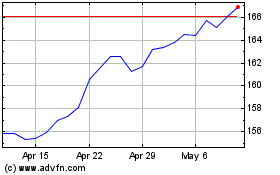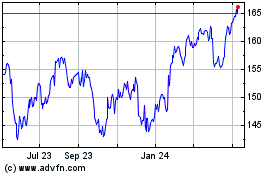P&G shifts pitch to appeal to millennials who 'don't know
what the product is for'
By Sharon Terlep
Procter & Gamble Co. has a fabric-softener problem.
Sales of the product -- an often sweetly scented liquid designed
to make clothes feel better after a wash -- have been declining for
more than a decade, hurt by improvements in modern washing machines
and laundry detergents, as well as heartier fabrics able to
withstand more washings without additives.
The Cincinnati consumer-products giant, which commands more than
half the $1.3 billion U.S. market for liquid softener with Downy
and Gain, says a new generation of shoppers, the coveted
millennials, have accelerated the decline. Shailesh Jejurikar,
P&G's head of global fabric care, told analysts recently that
most millennials "don't know what the product is for."
Fabric softener was popularized in the U.S. in the 1960s to
solve a common complaint that laundry emerged from washing machines
feeling rough and scratchy. But those complaints have been less
common following changes in detergents and washing machines that
have reduced the harshness of washing.
At the same time, popular athletic gear often comes with
instructions to avoid using softener because it can reduce the
ability of fabric to lift and trap moisture.
The result: U.S. liquid softener sales fell 15% between 2007 and
2015, with sales of P&G's market-leading Downy brand down 26%
in that period to $598 million, according to Euromonitor.
For P&G, the problem weighs on in its largest division,
fabric care, at a time when the company has been struggling to
offset slowing growth of its popular laundry pods. After years of
deep cost-cutting and scant growth, P&G is under pressure to
deliver sales gains.
P&G's organic sales -- a closely watched metric that strips
out currency moves, acquisitions and divestments -- have been
growing 1% to 3% annually for the last several years. In the years
leading up to the recession P&G's organic sales growth ranged
from 5% to double-digit gains.
Millennials and "eco-conscious" consumers are looking to limit
the amount of chemicals they use in their homes, dealing softeners
another blow, said Bibie Wu, vice president of fabric conditioning
for Germany's Henkel AG, which acquired Sun Products Corp., maker
of Snuggle fabric softener.
Some consumer and environmental advocates contend softener is
one of many household products that contains potentially unhealthy
chemicals. P&G and Sun maintain their products are safe. Downy
offers a softener free of dyes and perfumes, and Sun said scent-
and color-free products are a growing part of its portfolio.
Karen Repeckyj Vecchione, a 44-year-old mother of three from
Doylestown, Pa., stopped using liquid softeners and many other
household products after becoming pregnant with her first daughter
seven years ago. "I changed a lot of my cleaning substances then,"
she said. "I wanted her to have a good, toxin-free start to
life."
P&G views millennials as a prime target for increasing
softener sales because consumers in that age group are just
beginning to form their laundry habits, either because they are
living on their own for the first time, buying a first washing
machine or having children, said Nate Lawton, associate brand
director for P&G's North America fabric-care unit.
To that end, P&G changed the wording on its packaging last
year. It now refers to the product as "fabric conditioner," hoping
to draw a parallel to hair-conditioner as an integral part of many
hair-washing regimens. The company says liquid softener improves
longevity of clothes by protecting them in the wash, and makes
laundry look and smell better.
"Conditioning is the most intuitive and familiar way to talk
about this benefit for consumers," said Mr. Lawton.
P&G and its laundry-aisle rivals also are trying to fight
the downward slide with explanatory ad campaigns touting the
benefits of softener, which costs about $3 to $4 for a 50-ounce
bottle.
One recent Downy spot features footage from a GoPro video camera
inside a washing machine. A man's foreboding voice describes how
doing laundry "wreaks havoc" on clothes, "crushing them with 60
times the G-force of a rocket launch and baking them in a dryer
that can get hot enough to cook ribs."
It is a commercial designed for consumers like Nicholas Stephan,
a 26-year-old from Fort Wayne, Ind., who grew up using only
detergent. Frustrated that his clothes were getting worn out faster
than he could afford to replace them, Mr. Stephan recently went to
the store in search of a product that would help. After trying
dryer sheets and other items he realized he was buying the wrong
products. "It turns out I really needed fabric softener," Mr.
Stephan said.
Both P&G and Henkel said softener sales are responding to
the marketing push and have improved in recent months. That also is
because of new offerings such as so-called scent boosters -- small
beads that consumers put in washing machines to keep clothes
smelling clean longer. U.S. softener sales across all brands were
up 5% for the 12 months ended Oct. 1 compared with a year earlier,
according to Nielsen ratings.
To significantly boost sales, consumer-products companies should
focus on wooing more traditional customers, a feat that likely
would require profit-eroding discounts that P&G and rivals have
tried to move away from, said Kurt Jetta, CEO of TABS Analytics, a
retail- and consumer-analytics firm.
Still, Mr. Jetta says it will be hard to convince American
families to spend more on laundry. "Even if you are affluent or
have above-average income, it's an area where people are looking to
save money," he said.
Write to Sharon Terlep at sharon.terlep@wsj.com
(END) Dow Jones Newswires
December 17, 2016 02:47 ET (07:47 GMT)
Copyright (c) 2016 Dow Jones & Company, Inc.
Procter and Gamble (NYSE:PG)
Historical Stock Chart
From Aug 2024 to Sep 2024

Procter and Gamble (NYSE:PG)
Historical Stock Chart
From Sep 2023 to Sep 2024
